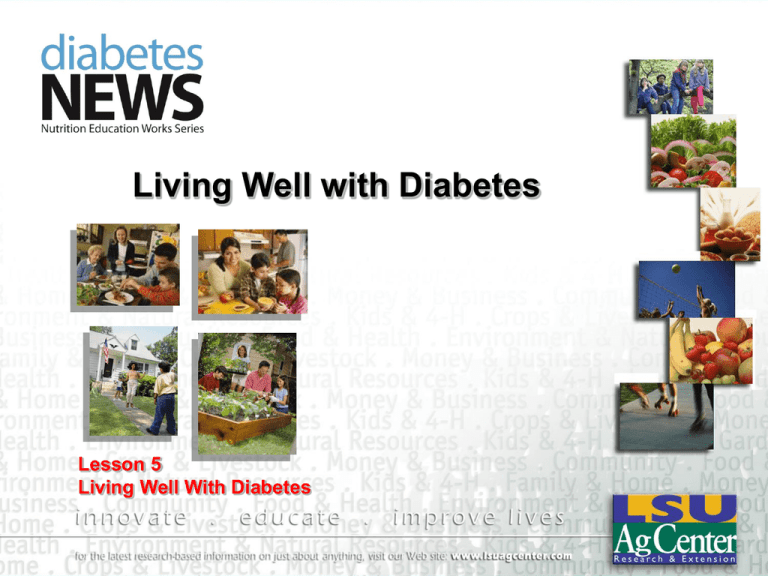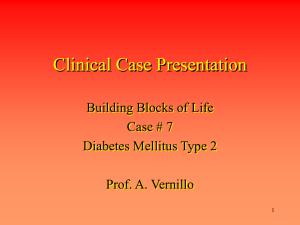Living Well With Diabetes - Power Point
advertisement

Living Well with Diabetes Lesson 5 Living Well With Diabetes The Bad News… • People with diabetes are at risk for a variety of problems • Problems can develop years after initial diagnosis • More likely to have: – Heart attack, stroke, eye problems, kidney disease, foot or leg amputation, frequent infections, sexual problems And The Good News… • Diabetes complications do not have to occur • People with diabetes can live long, healthful and productive lives Three Keys To Living Well with Diabetes • Education • Early Detection • Regular Doctor/Health Care Team Visits EDUCATION • Learn as much as you can about diabetes and its complications – How – What – Why EARLY DETECTION • Learn earliest signs and symptoms of potential problems • Know your lab test results • Keep track of changes REGULAR OFFICE VISITS • Make regular office visits with your diabetes care team • Set up a 3-month schedule and STICK TO IT! • Contact immediately if you are having problems • Working together = strong prevention team Keep A Check • Every Office Visit – – – – – Blood glucose Blood pressure Weight Review meal plan Discuss concerns • At least every 3-6 months – A-1-C • At least once a year – – – – – – – Physical exam Cholesterol Triglycerides Microalbumin Feet exam Dilated eye exam Flu shot • Every 5 years – Pneumonia vaccine Who Should Be On Your Team? • • • • • • Doctor Diabetes educator Dietitian Pharmacist Nurse Foot doctor • Eye doctor • Mental health counselor • Nurse practitioner • Dentist • Social worker • Family and friends How Do Problems Start? • Blood glucose levels consistently exceed 140 mg/dl • Physiological changes occur and affect organs and body functions • Having high glucose levels for long term leads to complications – Nerve damage, eye damage, kidney disease, dental problems, foot problems, etc. Take Care of Your Heart • Ask your doctor these questions: – What are my blood glucose, blood pressure and cholesterol numbers? – What should they be? – What actions should I take to reach these goals? Take Action Now To Reduce Heart Disease • Eat the right amounts of foods for your meal plan • Eat foods prepared with less salt and less fat • Get at least 30 minutes of physical activity every day • Maintain a healthy weight Take Action Now To Reduce Heart Disease • Stop smoking – seek help • Take medicines the way your doctor tells you to take them • Ask your family and friends to help Seeing After Your Eyes • Have eyes checked at least once a year • Tell your eye doctor if you: – See spots – See poorly in dim light – Have eye pain – Or any other eye problem Keeping Your Kidneys Fit • • • • • • • Get yearly screening for microalbumin Keep blood glucose tightly controlled Keep blood pressure in check Avoid medications that can damage kidneys Say no to nicotine Go easy on protein Use preventive medications when needed Taking Care of Your Tootsies • Wear comfortable shoes and clean, properly fitting thick socks • Wash your feet daily with lukewarm soapy water and dry well, especially between toes • Keep feet soft by using lotion after a bath or shower • Inspect daily cuts, scratches, redness or swelling Taking Care of Your Tootsies • Call health care provider if wound does not heal • Wear shoes with good support or diabetic shoes, if possible • Never go barefoot, even inside your home • Never, ever, do bathroom surgery on your own feet • See a podiatrist for foot care (surgery, trimming nails, medications) Don’t Deny Your Dental Care • Brush and floss your teeth daily • Have your teeth cleaned every 3 to 6 months • If you notice any problems, tell your dentist Your Sick Day Plan • When to call your physician: – Fever – Uncontrolled vomiting or diarrhea – High ketone count – Glucose levels above 240 – Do not know what to do Things to Do… • Take your medicines for diabetes • Make sure to check blood sugar often • Try to eat and drink according to your meal plan as much as possible • 50 grams carbohydrates every 3-4 hours • Write down blood sugar levels, ketone levels, what you eat and medicines taken!!! Handy Sick Day Foods • • • • • • • • Gatorade Milk Soup Fruit juice Regular soft drinks Crackers Dry toast Cooked cereal • • • • • • Frozen yogurt, sherbet Sugar-free pudding Mashed potatoes Regular pudding Custard Peanut butter Be Food Safe 4 Basic Steps . . . • • • • Clean Separate Cook Chill Clean • Wash hands and surfaces often Separate • Don’t cross-contaminate Cook • Cook to proper temperatures Chill • Refrigerate promptly Making Wise Food Choices • Foods most likely to contain pathogens include: –Uncooked fresh fruits and vegetables –Animal products Type of Food Meat, Poultry & Seafood Milk Eggs Higher Risk Raw or undercooked Unpasteurized Raw or undercooked Sprouts Raw Vegetables/Fruits Unwashed Cheese Soft Hot Dogs/Deli Meats Not reheated Lower Risk Cooked to safe temperature Pasteurized Pasteurized Cooked Washed Hard/processed/ pasteurized Reheated Tips for Safe Shopping • Check the “sell by” date. • Put raw meat, poultry or seafood in plastic bags. • Buy only pasteurized milk, cheese, dairy products and juices. • Keep it safe when buying eggs. • Don’t buy food displayed in unsafe or unclean conditions. Transportation Issues • Pick up perishable foods last. • Follow the “2 hour rule.” • Consider a cooler. Dining Out • Ask about uncooked ingredients. • Request a safe minimum temperature. • To minimize your risk of getting a foodborne illness it is wise to avoid restaurant buffets. • Keep the “doggy bag” safe. Uh Oh . . . • Know the symptoms: – Nausea – Vomiting – Diarrhea – Fever I Don’t Think We’re in Kansas Anymore . . . • Preparing for Emergencies Before the Storm • Prepare a waterproof insulated emergency kit including standard emergency supplies plus: – At least 3 days of diabetes supplies – Carbohydrate source along with water and food – A list of emergency contacts and medications – Prescription bottles or numbers so you can replace medications at a pharmacy, if needed – Cooler with at least 4 re-freezable gel packs for storing insulin (if you’re using insulin) Play It Safe • Consider wearing medical identification. • Identify school personnel to help with children. • Wear sturdy shoes. • Pack 2 to 3 days of extra clothing. • Keep immunizations up to date. • Keep your cell phone charged. • Have a plan. During the Storm • Identify yourself as a person with diabetes. • Drink plenty of water. • Watch what you eat and carry a fast source of sugar with you at all times. • Stick with your testing and medication schedule. • Check your feet! Have Diabetes. Will Travel. Plan Ahead • Have a medical exam • Control your ABCs • Ask for prescription and letter explaining medications, supplies and allergies • Acquire medical identification • Learn to say: “I have diabetes” and “sugar or orange juice, please” in the language of the countries if traveling abroad Plan Ahead • Plan for time zone changes • Find out flight times, and if meals will be served, ask for special meal • Always carry enough food to cover flight time and delays Travel Preparations • Take twice the amount of medication and supplies you need normally; pack at least half in carry-on bag • Carry-on bag – – – – – – – All the insulin and syringes you will need for trip Blood and urine testing supplies Extra batteries for glucose meter All oral medications Other medications or medical supplies Your ID and medical identification Emergency snacks Travel Preparations • Keep insulin cool by packing in insulated bag with refrigerated gel packs. • Pack a first-aid kit. • Don’t forget a sharps container. • Notify airport security that you have diabetes. • Have all medications and delivery systems clearly marked with prescription labels intact. You Can Be Your Own Worst Enemy . . . or Your Own Best Friend Acceptance of Diagnosis Denial Depression Anger Bargaining Acceptance Worst Enemies • • • • • • • • I’m tired and this is how I relax. These foods taste good. I eat more when I am stressed. I don’t want to think about whether foods are healthful or not. I don’t want to face my diabetes. Everyone is nagging me. I don’t want to worry my family. It’s too hard to make it to the doctor. Best Friends • I want to protect my family from losing me. • I am ready to face reality and do something about my diabetes. • I am willing to try something new. • I am willing to take charge and to take action. • I am willing to ask for help. • My family is important to me, and they can help. • I should share what I am feeling with my family. Are You Ready to Change??? • Precontemplation • Contemplation • Preparation • Action • Maintenance How Can I Be My Best Friend? • • • • • • • Tell yourself you can do it. Pat yourself on the back for positive changes. Ask for help when you need it and share your fears. Seek out positive people. Believe that you deserve to have a healthy body. Don’t beat up on yourself. Don’t let yourself get away with excuses. How Can I Help My Family Member? • • • • • • • Learn about diabetes. Understand your loved one’s diabetes. Find out what your loved one needs. Talk about your feelings. Offer practical help. Try a new approach. Get help. Diabetes Does Not Control Me I Control My Diabetes References • American Diabetes Association • National Diabetes Education Program • The Diabetic Bible by Dana Armstrong and Allen Bennett King • Diabetes Life Lines – The University of Georgia Cooperative Extension • U. S. Food and Drug Administration • U. S. Department of Agriculture’s Food Safety and Inspection Service • Diabetes Prevention and Control Program • Journey for Control…Advancing Diabetes Education by Merck and Company Living Well With Diabetes Prepared By: Terri Crawford, Extension Agent, Nutrition, Northeast Region Cathy Agan, Extension Agent, FNP Ouachita Parish






